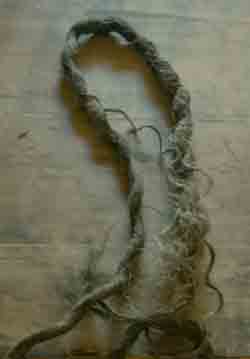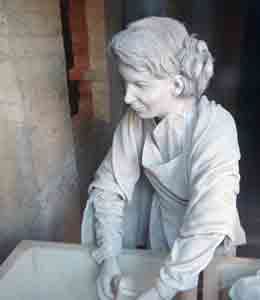Types of work required of workhouse inmates

Workhouse inmates had to work hard to fund their keep, but you may not have realised quite how hard it was. This page details the types of work done by men and women and explains why the men's work varied from one location to another.
____
By the webmaster's mother (1906-2002) from discussions with her father who was a workhouse labour master and her uncle who chaired the local Board of Guardians which oversaw the local workhouse system, edited with further research by the webmaster
All the adult inmates of workhouses had to work to fund their keep. The men and the women had different work.
Men's work in the workhouse
Men in the workhouse who were able-bodied had to work at hard manual labour. This was certainly unpleasant, but it was not primarily a punishment. These jobs had to be done and there were no machines to do them. However, workhouse life was not intended to be pleasant.
Teasing out old rope
One job was to tease out the strands of worn-out rope from ships, so that the fibres could be used for other purposes. A tool like a large nail was used. I assume it was called a spike which must have given rise to the informal name of 'spikes' for the associated casual wards where the work was similar. The ropes were tarred, and therefore gritty, so made fingers bleed.

Tarred old rope

Bucket of teased out rope fibres
Stone breaking
Another job was to break up rocks for building and mending roads.
Family notes, left by Edward Cole, son of the Edmonton labour master and brother of the author of this page
The main task at the Edmonton workhouse was stone breaking - breaking up lumps of granite into knobs, about 1½ inches across, which were used in making macadam roads. Macadam was these knobs, set in sand and compacted by rolling. The district was fast developing in the early 1900s - and there was a large demand for this material.

Section through a reconstruction of an early 1900s road at Amberley Heritage Museum, showing crushed rocks

Breaking rocks. Screen shot from an old film. The movement on the video shows the enormous effort required to raise hammer above the head before striking it.

Grid bars on cell windows which could be lowered to to act as sieves to keep the broken rocks small
My father had a large hammer in our shed at home which came from the workhouse. It was very heavy indeed and pointed at the lower end to split into the rocks more readily.
The pieces of rock had to be small enough to go through a 1½ inch heavy-weight sieve - just under 4 cm.
In some areas, particularly older ones, roads were finished with round stones set in concrete, called cobbles. I liked to watch the horses clattering across these cobbles on dark, winter days, as their iron horseshoes caused blue sparks.
contributed by Mary Wilkinson
How men's work depended on location
Different areas had different needs for work by able-bodied men. No doubt some were involved in farm work with all that that entailed, and you can probably suggest other types of necessary work in different locations. Although workhouses were rather like prisons in some respects, there was no chance of the men escaping by working on somewhere away from the workhouse. They needed to get back for food and bed, basic as this was.
Women's work in the workhouse
The women in the workhouses had to work very hard too.
Washing and ironing
The women had to wash everything that needed washing. At Edmonton, they did this in the infirmary laundry.
There were no washing machines or washing powders. So the women had to use their bare hands, carbolic soap, washboards, mangles and flat irons. It was hot, steamy work. I often wondered if they had any treats, as the men had their tobacco.

Woman workhouse inmate doing washing.

Woman workhouse inmate doing washing, front view.
The models at Guildford Spike are full-sized and seem to be made of white unpainted plaster, which looks particularly effective for the circumstances.
Food preparation and cooking
It also fell to the women to do whatever mending was necessary and to prepare and cook the meals - basic as these were.
All the photos on his page, with the exception of the crushed road stones, were taken with permission at The Guildford Spike.
| sources | webmaster | contact |
Text and images are copyright
If you can add anything to this page or provide a photo, please contact me.



